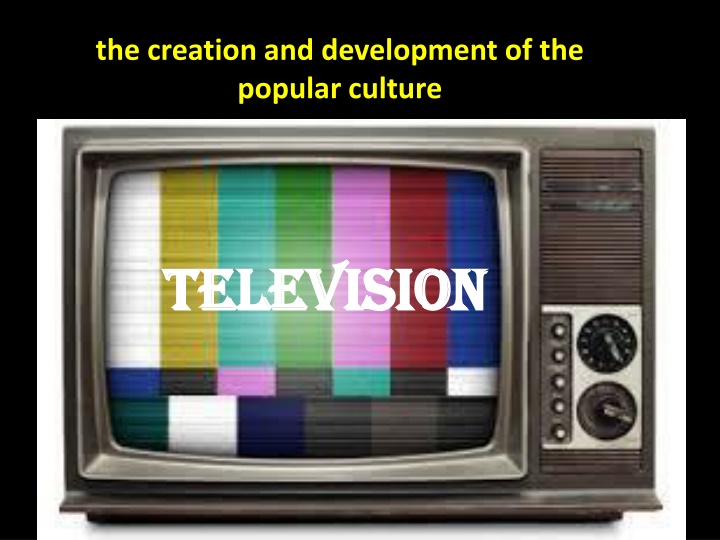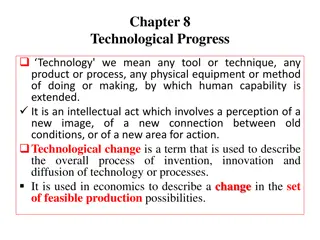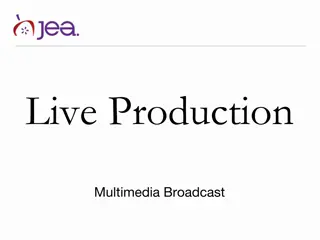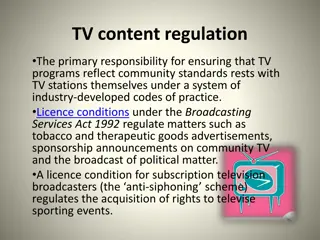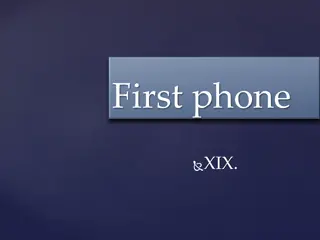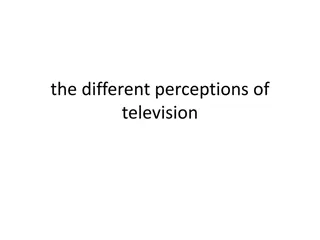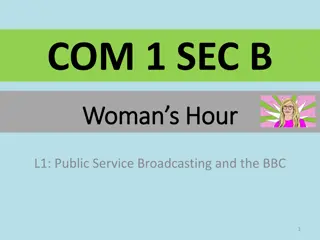The Evolution of Television: From Baird's Invention to Modern Broadcasting
Television has evolved from its humble beginnings with John Logie Baird's invention to become an integral part of modern life, offering entertainment, advertising, and diverse programming. The journey of television includes significant milestones such as the demonstration of color television, transatlantic transmissions, and the development of high-definition services. Discover the fascinating history and development of television as we know it today.
Uploaded on Oct 10, 2024 | 0 Views
Download Presentation

Please find below an Image/Link to download the presentation.
The content on the website is provided AS IS for your information and personal use only. It may not be sold, licensed, or shared on other websites without obtaining consent from the author.If you encounter any issues during the download, it is possible that the publisher has removed the file from their server.
You are allowed to download the files provided on this website for personal or commercial use, subject to the condition that they are used lawfully. All files are the property of their respective owners.
The content on the website is provided AS IS for your information and personal use only. It may not be sold, licensed, or shared on other websites without obtaining consent from the author.
E N D
Presentation Transcript
the creation and development of the popular culture Television Television
the origins The television has become such an integral part of homes in the modern world that it is hard to imagine life without television. Not just for entertainment value, but TV is also a valuable resource for advertising and different kinds of programming.
John Logie Baird John Logie Baird and the invention of the television are part of History. But the idea of the television did not start with Logie Baird in the 1920 s. In the late C19th, a number of scientists had made important discoveries that Baird would use in his first version of a television.
Henri Becquerel found that light could be changed into electricity and, importantly, Ferdinand Braun had invented the cathode ray tube. By the 1920 s there were 50 serious attempts to invent the television from Russia, America, Germany, Britain and Japan.
By 1925, John Logie Baird was ready to give the first public display of a working television. The chosen place was Selfridges in Oxford Street, London. Shoppers saw slightly blurred but recognisable images of letters.
In 1927, Baird demonstrated colour television and a video-recording system he called a "Phonovision". In 1928, Baird made the first transatlantic television transmission and one year later he started regular 30-line mechanical broadcasts.
In 1936, the BBC started the worlds first regular high-definition service from Alexandra Palace using the Baird system, though it was abandoned one year later in favour of a system developed by Marconi-EMI. BY 1939, 20,000 television sets were in use in Great Britain, just 14 years after Baird s first public demonstration of his system at work. In 1940, Baird gave a demonstration of a high- definition full colour stereo television.
the development of tv from a local to a global level As we have seen television started off small and has become a major product in society today. What do you think were the main reasons for the success of television? What is the main factor that increased access to television, thus allowing it to become a global sensation?
Activity Television in Australia Go to http://televisionau.com Answer the following questions while navigating the site... 1. What impact did WWII have on television coming to Australia? 2. When did the first transmission tests occur in Australia? 3. Name 2 of the first television programs to be aired in Australia? 4. What is the significance of soaps on Australian tv? 5. When were soaps popular? Why is this popularity declining now? 6. Click on the flashbacks tab. What can these pictures tell us about Australian Television? 7. Can these pictures be used to study societal progress? How? 8. Write a page in your books explaining what you can learn from these flashbacks. Include things like representation of society, fashion, values, attitudes etc.
the process of commodification for television Commodification is a term that only came into currency in 1977, but expresses a concept fundamental to Marx s understanding of the way capitalism develops.
Examples of commodification include: The socialisation of women s labour, with work such as preparing meals, caring for children, repairing and cleaning clothes and so on, now being purchased on the market, very often from women who are selling their labour power for a wage rather than offering the same service within a relationship of domestic servitude called marriage;
The privitisation of government services, with work such as education, public transport and health care, water supply, road works being provided on a user-pays system, instead of as public services, which in many cases were provided out of tax revenue and delivered to the public free of charge;
The commercialisation of scientific and cultural activities through the increasing pressure conveyed through funding mechanisms to orient activity towards serving commercial rather than human interests; The professionalisation of amateur sports and services, to a point when playing a game involves working out at 5 a.m., and your teenage neighbour needs a degree in early childhood development and a salary before she will be allowed to baby-sit;
What are some examples of the commodification of television? Foxtel Pay-per-view Companies making a product, eg. Television show, and selling these to broadcasting companies (NBC, Harpo productions, fox, Disney etc) Now read through Article on commodification of television.
the role of mythology in the creation and perpetuation of the popular culture A mythology is the entirety of all the myths, legends, and traditional beliefs of a specific culture, people, or region. The term can also mean "the study of myths, .
Mythology theory Mythology theory can be applied to understand the appeal of certain television genres and the kinds of meanings they encode. The myth of the hero continues on in contemporary adventure series, the journey myth is recycled in programs that show far away places to visit etc.
In addition, some of the genres employ mythological concepts that reflect social change. Consider, as an example, the mythology of fatherhood that television has constructed and continually reshaped from the 1950 s to present day.
Early sitcoms sculpted the father figure to fit the template of the traditional patriarchal family. The father was in charge, with his wife working behind the scenes to maintain harmony among the family members. This image of fatherhood has changed throughout the years to reflect societies changes.
When we talk about mythology of television, we are talking about the archetypal characters, familiar scenarios and the lessons to be learned from television. Take for instance the television series Dexter
In Dexter we see a vigilante serial killer who works for Miami metro homicide as a blood spatter analyst. Yes, there are many incongruities within this statement alone! How does Dexter represent mythology of television?
To start with we have the age old battle between good and evil. Dexter must wrestle with these concepts on an episodic basis. Should he kill? Should he do his job within the law? If he chooses to kill, who will fit his code and make that killing justifiable?
On top of this, Dexter also struggles to fulfil the roles in life that have been assigned to him. Husband, father, brother, son. It is through these roles and the struggles Dexter faces that we can recognise the mythology of roles within society.
Another example of mythology in Dexter can be seen in his sister Debra Morgan. Deb is a hard arsed, ball baring foul mouthed police officer who also struggles to fulfil her assigned roles in life. Daughter, sister, officer, lover. Although Deb does not seem to fit the usual female role of television character, closer inspection reveals she does so with ease.
Deb is symbolic of young professional women. She struggles with relationships as many other single female characters do (eg. Carrie of Sex and The City). She must always remain calm and confident and vulnerability is a sign of weakness.
What characters from television can you identify that fit archetypal or stereotypical roles that are a reflection of our society? Have these mythologies changed? How?
continuities and changes to the popular culture
the role of mythology in the creation and perpetuation of tv
